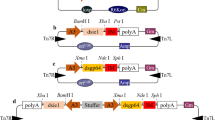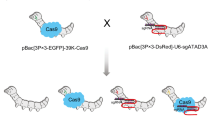Abstract
RNA interference (RNAi) has become an efficient tool for inducing resistance to viruses in many organisms. In this study, Escherichia coli cells were engineered to produce stable double-stranded RNA (dsRNA) against the nucleopolyhedrosis virus to elicit RNAi in silkworms. The immediate-early-1 (ie-1) and late expression factor-1 (lef-1) genes of the Bombyx mori nucleopolyhedrovirus (BmNPV) involved in viral DNA multiplication were cloned in the plasmid L4440 under the influence of the double T7 promoter and transformed to E. coli HT115 DE3 host cells. On induction with isopropyl β-d-thiogalactopyranoside, these cells efficiently produced dsRNA of the cloned genes. The B. mori larvae were fed with 50 µL of E. coli cells expressing ie-1 and lef-1 dsRNAs (each approximately 25 µg) to elicit RNAi. The semi-quantitative and quantitative PCR analysis of RNA from the midgut of the dsRNA-fed larvae revealed a significant reduction in the expression of the target genes involved in BmNPV multiplication, which restricted virus copy numbers to 100 compared with 1.9 × 105 in the infected controls. Furthermore, the dsRNA-fed infected larvae showed > 50% increased survivability compared with the infected controls. The study revealed the successful use of bacteria as vectors for efficiently delivering dsRNA to elicit RNAi against BmNPV in silkworms.




Similar content being viewed by others
References
Khurad AM, Mahulikar A, Rathod MK, Manoj R, Kanginakudru S, Nagaraju J (2004) Vertical transmission of nucleopolyhedrovirus in the silkworm, Bombyx mori L. J Invertebr Pathol 87:8–15
Terenius O, Papanicolaou A, Garbutt JS, Eleftherianos I, Huvenne H et al (2011) RNA interference in Lepidoptera: an overview of successful and unsuccessful studies and implications for experimental design. J Insect Physiol 57:231–245
Tabunoki HS, Ninagi O, Fujii H, Banno Y, Nozaki MA (2004) Carotenoid-binding protein (CBP) plays a crucial role in cocoon pigmentation of silkworm (Bombyx mori) larvae. FEBS Lett 567:175–178
Ohnishi A, Hull JJ, Matsumoto S (2006) Targeted disruption of genes in the Bombyx mori sex pheromone biosynthetic pathway. Proc Natl Acad Sci USA 103:4398–4403
Liu W, Yang F, Jia S, Miao X, Huang Y (2008) Cloning and characterization of Bmrunt from the silkworm Bombyx mori during embryonic development. Arch Insect Biochem Physiol 69:47–59
Dai H, Ma L, Wang J, Jiang R, Wang Z, Fei J (2008) Knockdown of ecdysis-triggering hormone gene with abinary UAS/GAL4 RNA interference system leads to lethal ecdysis deficiency in silkworm. Acta Biochim Biophys Sin 40:790–795
Masumoto M, Yaginuma T, Niimi T (2009) Functional analysis of Ultrabithorax in the silkworm, Bombyx mori using RNAi. Dev Genes Evol 219:437–444
La Fauce K, Owens L (2012) RNA interference with special reference to combating viruses of crustacea. Indian J Virol 23:226–243
Kanginakudru S, Royer C, Edupalli SV, Jalabert A, Mauchamp B, Chandrashekaraiah, Prasad SV, Chavancy G, Couble P, Nagaraju J (2009) Targeting ie-1 gene by RNAi induces baculoviral resistance in Lepidopteran cell lines and in transgenic silkworms. Insect Mol Biol 16:635–644
Tamura T, Thibert C, Royer C, Kanda T, Abraham E, Kamba M et al (2000) Germline transformation of the silkworm Bombyx mori L. using a piggyBac transposon-derived vector. Nat Biotechnol 18:81–84
Isobe R, Kojima K, Matsuyama T, Quan GX, Kanda T, Tamura T, Sahara K, Asano SI, Bando H (2004) Use of RNAi technology to confer enhanced resistance to BmNPV on transgenic silkworms. Arch Virol 149:1931–1940
Subbaiah EV, Royer C, Kanginakudru S, Satyavathi VV, Babu AS, Sivaprasad V, Chavancy G, Darocha M, Jalabert A, Mauchamp B, Basha I, Couble P, Nagaraju J (2013) Engineering silkworms for resistance to Baculovirus through multigene RNA interference. Genetics 193:63–75
Zhang P, Wang J, Lu Y, Hu Y, Xue R, Cao G, Gong C (2014) Resistance of transgenic silkworm to BmNPV could be improved by silencing ie-1 and lef-1 genes. Gene Ther 21:81–88
Olson VA, Wetter JA, Friesen PD (2002) Baculovirus transregulator IE1 requires a dimeric nuclear localization element for nuclear import and promoter activation. J Virol 76:9505–9515
Mikhailov VS, Rohrmann GF (2002) Baculovirus replication factor LEF-1 is a DNA primase. J Virol 76:2287–2297
Acharya A, Sriram S, Sehrawat S, Rahman M, Sehgal D, Gopinathan KP (2002) Bombyx mori nucleopolyhedrovirus: molecular biology and biotechnological applications for large scale synthesis of recombinant protein. Curr Sci 83:4
Katsuma S, Mita K, Shimada T (2007) ERK- and JNK-dependent signaling pathways contribute to Bombyx mori nucleopolyhedrovirus infection. J Virol 81:13700–13709
Li Y, Shen S, Hu L, Deng F, Vlak JM, Hu Z, Wang H, Wang M (2018) The functional oligomeric state of tegument protein GP41 is essential for Baculovirus budded virion and occlusion-derived virion assembly. J Virol 92:e02083-17
Brutscher LM, Flenniken ML (2015) RNAi and antiviral defense in the honey bee. J Immunol Res. https://doi.org/10.1155/2015/941897
Scott JG, Michel K, Bartholomay LC, Siegfried BD, Hunter G, Smagghe WB, Zhu KY, Douglas AE (2013) Towards the elements of successful insect RNAi—review. J Insect Physiol 59:1212–1221
Turner CT, Davy MW, MacDiarmid RM, Plummer KM, Birch NP, Newcomb RD (2006) RNA interference in the light brown apple moth, Epiphyas postvittana (Walker) induced by double-stranded RNA feeding. Insect Mol Biol 15:383–391
Baum JA, Bogaert T, Clinton W, Heck GR, Feldmann P, Ilagan O, Johnson S, Plaetinck G, Munyikwa T, Pleau M, Vaughn T, Roberts J (2007) Control of coleopteran insect pests through RNA interference. Nat Biotechnol 25:1322–1326
Tian H, Peng H, Yao Q, Chen H, Xie Q, Tang B, Zhang W (2009) Developmental control of a Lepidopteran pest Spodoptera exigua by ingestion of bacterial expressing dsRNA of a non-midgut gene. PLoS ONE 4:e6225
Surakasi VP, Mohamed AM, Kim Y (2011) RNA interference of beta 1 integrin subunit impairs development and immune responses of the beet armyworm, Spodoptera exigua J. Insect Physiol 57:1537–1544
Yang J, Han Z (2014) Efficiency of different methods for dsRNA delivery in cotton bollworm (Helicoverpa armigera). J Integr Agric 13:115–123
Piot N, Snoeck S, Vanlede M, Smagghe G, Meeus I (2015) The effect of oral administration of dsRNA on viral replication and mortality in Bombus terrestris. Viruses 7:3172–3185
Timmon L, Fire A (1998) Specific interference by ingested dsRNA. Nature 395:854
Timmon L, Court DL, Fire A (2001) Ingestion of bacterially expressed dsRNAs can produce specific and potent genetic interference in Caenorhabditis elegans. Gene 263:103–112
Yu N, Christiaens O, Liu J, Niu J, Cappelle K, Caccia S, Huvenne H, Smagghe G (2013) Delivery of dsRNA for RNAi in insects: an overview and future directions. Insect Sci 20:4–14
Yogindran S, Rajam MV (2015) RNA interference strategy for crop protection against insect pests. In: Soberon M, Gao Y, Bravo A (eds) Bt resistance, characterization and strategies for GM crops producing Bacillius thuringiensis Toxins. CABI Biotechnology Series 4. CAB International, Oxfordshire, pp 162e172
Acknowledgements
This Research was funded by Central Silk Board, Bengaluru and Technical Collaboration was provided by Professor M.V. Rajam, Department of Genetics, UDSC, New Delhi. The authors would like to acknowledge Dr. Geetha Murthy, Scientist, CSGRC, Hosur and Editingindia for meticulously editing the Manuscript.
Author information
Authors and Affiliations
Corresponding author
Ethics declarations
Conflict of interest
The authors declare no conflict of interest.
Additional information
Publisher's Note
Springer Nature remains neutral with regard to jurisdictional claims in published maps and institutional affiliations.
Electronic supplementary material
Below is the link to the electronic supplementary material.
Rights and permissions
About this article
Cite this article
Ismail, S., Tulsi Naik, K.S., Rajam, M.V. et al. Targeting genes involved in nucleopolyhedrovirus DNA multiplication through RNA interference technology to induce resistance against the virus in silkworms. Mol Biol Rep 47, 5333–5342 (2020). https://doi.org/10.1007/s11033-020-05615-z
Received:
Accepted:
Published:
Issue Date:
DOI: https://doi.org/10.1007/s11033-020-05615-z




